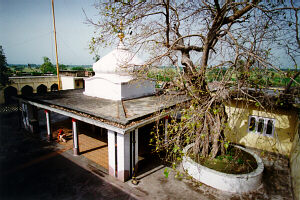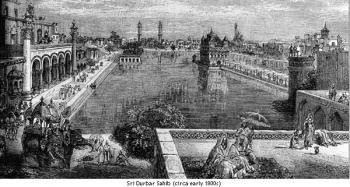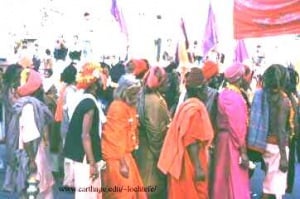Udasi
| This article may contain Sects or Cults, Fake Babas, Deras, Fake Nihangs, Sanatan Dharmis, Pseudo Akalis & Mahants, Pseudo Intellectuals & Historians, Leftists and agnostic which are not considered a part of Sikhism. The article is just for information purposes.
Please do not amended this article. If you have any comments, please discuss them here |
'Udasi' is an ascetic sect founded by Baba Sri Chand (1494-1629), the elder son of Guru Nanak Sahib Ji. The word 'Udasi' is derived from the Sanskrit word which means "one who is indifferent to or disregardful of worldly attachments, a stoic, or a mendicant." In Sikh tradition, the term udasi has also been used for each of the four preaching tours of Guru Nanak Sahib Ji; in this sense, udasi meant a prolonged absence from home. Some scholars, including many Udasis, trace the origin of the sect back to the Puraṇic age, but, historically speaking, Baba Sri Chand was the founder. Udasis are not Sikhs.
Baba Sri Chand was a saintly person. It is said that his object in establishing the order of the Udasis was to propagate the teachings of his father, but it is a fact that the religious discipline and practices observed by this sect were not in line with Guru Nanak Sahib Ji's teachings and Maryada (tradition) instructed. Baba Sri Chand kept on amicable terms with the successors of Guru Nanak Sahib Ji. According to Kesar Siṅgh Chhibbar, he sent two turbans at the death of Guru Raam Daas Ji in 1581, one for Prithi Chand, the eldest son of the fourth Guru, and another for Guru Arjan Dev Ji in recognition of his succession to the Guruship. On the other hand, Guru Amar Daas Ji, took steps to keep the Udasi sect separate from Sikhism. There was a basic difference between the two sections. The Sikhs believed in family-life, while the Udasis believed in celibacy. The Udasis wanted to join Sikhism on their own terms to which the Guru did not agree. Narang observes in his connection: "The Sikhs were once for all separated from Udasis, and raised above asceticism, were free and fit to follow their course of national progress" (G.C. Narang: Transformation of Sikhism, p.33). J. D. Cunningham writes that Guru Amardaas Ji was "active in preaching and successful in obtaining converts. He found an attentive listener in the tolerant Akbar. He saved the infant church from early death by wholly separating the passive and recluse Udasis from the regular Sikhs" (J. D. Cunningham: A History of the Sikhs, p.45).
At First Udasis were Zealous Teachers of Sikhi
Generally, the Udasis proved zealous preachers of Sikh teachings and carried its message to the far corners of the country and beyond. They especially rediscovered places which had been sited by the Guru Sahibs and which had fallen into obscurity with the passage of time. They established on such spots their ḝeras and saṅgats and preached from Gurbaṇi. Thus the Udasi centres popularized the teachings of Guru Nanak Sahib Ji not only in the Punjab but also in far off places.
The Udasis preached the message of Gurū Nĝnak and revered and recited the bĝṇī of the Gurūs, but they retained their separate identity. Bĝbĝ Srī Chand did occasionally visit the Sikh Gurus who treated him with respect for being a saintly personage as well as for being a son of Guru Nanak Sahib Ji. But they extended no patronage to his sect or religious group. A notable Udasi sadhu in Sikh history is Mahant Kirpal who took part in the Battle of Bhaṅgĝnī (1689) under Guru Gobind SinghJi.
After the abolition of the order of the masands by Guru Gobind Siṅgh Ji, the preaching of Guru Nanak Sahib Ji’s word fell to the Udasis who also gradually took control of the Sikh places of worship. When Guru Gobind Siṅgh Ji evacuated the Fort of Sri Anandpur Sahib along with his Sikhs, an Udasi monk, Gurbakhsh Daas, undertook the task to look after the local shrines such as Sīs Gañj and Kesgaṛh Sahib. When after the death of Guru Gobind Siṅgh Ji, one Gulaab Rai, an impostor proclaimed himself guru at Anandpur Sahib and tried to take possession of the shrines, Gurbakhsh Daas thwarted his scheme. Gurbakhsh Daas successors continued to look after the Anandpur Sahib shrines till their management was taken over in recent times by the Sikhs under the Shiromaṇī Gurdwĝrĝ Parbandhak Committee.
At Nĝnder where Guru Gobind Siṅgh Ji passed away, Mahant Ishar Daas Udasi performed the services at Darbaar Guru Gobind Siṅgh (Hazoor Sahib) and managed the shrine from 1708 to 1725. He was succeeded by his disciple Gopal Daas Udasi, who remained incharge of Darbaar Hazoor Sahib up to 1746. Gopal Daas was succeeded by his disciple Saran Daas Udasi, who served the shrine for a long period of 30 years. After Saran Daas the control of the Darbaar passed into the hands of the Sikhs who had, by that time, come from the Punjab in considerable numbers and settled at Nander.
Udasis recruit their followers from all castes and professions. In their religious practices they differ from the Sikhs, though they revere Guru Nanak Sahib Ji and Guru Granth Sahib Ji like all other Sikhs. In their monasteries, Guru Granth Sahib Ji is the scripture that is read. However, after the SGPC was made, fewer deras keep Guru Granth Sahib installed there, fearing the Sikhs could take over the management of the deras. They do not subscribe to the Sikh rites. Their ardaas also varies. Ringing of bells (ghaṇṭī or ghaṛīĝl), blowing instruments (narsiṅghĝ or siṅghī) form part of their religious service. They worship idols of Guru Nanak Sahib Ji and Baba Sri Chand, a practice strictly condemned by all the Sikh Gurus and Guru Granth Sahib Ji. Their salutations are Vaahguru (Glory of the God), Gajo Ji Vaahguru (Hail aloud the glorious Lord) or Alakh (Hail the Unknowable). The Udasis engage in pancadevopasana, the worship of a combination of five deities or the five qualified facets of the Brahman, namely Shiva, Vishnu, Surya, Durga, and Ganesh, and their philosophy is that of monistic or advaita Vedanta as popularised by Adi Sankaracarya. Amongst Udasis, some are celibate ascetics, others householders, some are jatadhari (dreadlocked) ash-covered Sadhus, and others have no distinctive appearance. Not only are they scholars of Sanskrit, their particularly adept in Ayurveda, the tradition Indian medicine.
Some of the Udasis wear white while others prefer gerūĝ (ochre) or red-coloured garments. Those belonging to the Nĝngĝ sect remain naked, wearing nothing except a brass chain around their waist, which is contrary to the way of the Sikhs. Some wear matted hair and apply ashes over their body. Some wear cord worn around the head, neck and waist. They abstain from alcohol, but use bhang (hemp), charas and opium. They practise celibacy. Their beliefs, discipline and identity does not qualify Udasis to be Sikhs unless they become Amritdhari and embrace the Sikh faith.
Besides disseminating the word of Guru Nanak Sahib Ji, Udasi centres serve as seminaries of Sikh learning, which takes heavy influence from Brĝhmanism. Chelĝs, i.e. disciples, gather around the head of the monastery who instructs them in Sikh and old classical texts. The heads of these centres travelled with their pupils to places of pilgrimage and participated in debate and discourse.
The Udasi buṅgĝs or rest houses around the Harimandar Sĝhib were among the prominent centres of learning. Udasi cloister at Amritsar, Brahm Būṭĝ Akhĝṛĝ, ran a Gurmukhi school which attracted a considerable number of pupils. Some Udasi centres also imparted training in Indian system of medicine and physiology. One such seat was the buṅgĝ of Paṇḝit Saroop Daas Udasi who was a great scholar as well as an authority on Charaka Samhitĝ, the famous treatise on Ayurveda.
The Dharamsalas or Gurdwaras are Fundamental to Sikhi
The central Sikh institution has since the time of Guru Nanak Sahib Ji been the Dharamsala. With the general persecution of Sikhs from the time of Banda Singh Bahadur until the latter part of the 18th century, the Dharamsalas or Gurdwaras had to be abandoned and the control fell into non-Khalsa hands. Udasis and Hindu devotees of the Gurus took control of the Gurdwaras and "began to act independent of Panth and Panthic ideology and reverted to old Hindu religious practices. " Udasis "believed in the Vedas, the Puranas and the Shastras" and were even classified as a Hindu sect by Cunningham in his book History of the Sikhs. Sikh dharamsalas began to be operated in a fashion similar to Hindu temples with the treatment of Guru Granth Sahib Ji as an idol, the actual installation of Hindu idols and restrictions on lower castes in worship. Even the celebration of Gurpurabs was Hinduised with sharadhs being held in memory of the Gurus . When the Sikhs became rulers of the Punjab, the dharamsalas remained in the hands of non-Sikh Udasis and thus rather than promoting true Sikh ideals, dharamsalas promoted a Vedantic and Hinduised mutation of Sikhism.
The Singh Sabha Moves to Clear Sikh Gurdwara' of Hindu Practices==In the early 20th century, the Singh Sabha movement began the task in freeing the Gurdwaras and dharmsalas, and undertook the important step in reviving the Sikh tradition.
Time of origin: 1494 (birth of Baba Siri Chand Maharaj), established as an institution in early 1600s
Doctrines and Origin
Time of origin: 1494 (birth of Baba Siri Chand Maharaj), established as an institution in early 1600s.
- Udasis are usually celibate and renounce worldly cares, but still regard themselves as Sikhs. Anand Ghan (see below) believed that Baba Sri Chand was an incarnation of God, and the only successor of Guru Nanak. Ghan also believed in many Brahmanical-cum-Hindu ideas that the Sikh Gurus did not advocate. These included the theory of the incarnation of God, Brahmanic rituals and practices and the belief in the necessity of renunciation, the practice of austerities, asceticism and celibacy, though most cut their hair. These largely Vedantic, philosophical beliefs led them away from Bhakti (loving devotion of the divine) to a knowledge and meditation of the divine, such that there was a shift from a personal God to an impersonal reality. Although they believe in the Adi Granth and pay it great respect, they do not believe in the householder (grihasti) of the Gurus, nor the doctrines of Guru Panth and Guru Granth, nor in the accumulation of wealth and property. Furthermore Guru Nanak's definition of 'udas' was "to make use of all things in this world and not deem them one's own, but only God's property, and ever to possess a desire to meet Him in udas". (See Foundation, Evolution and Transformation of the Sikh Panth entries).
History
- The Udasis were founded by Baba Sri Chand (1494-1629), the eldest son of Guru Nanak. Udasi, from the root 'udas' means detachment, withdrawal from worldly life, solitary, sadness and grief, and so refers to one who renounces. Traditionally he is said to have opposed his father's appointment of Guru Angad as the second Guru, and so he started his own order. He lived a celibate life of renunciation and asceticism. During the seventeenth century the Udasis grew in number and were respected by the early Sikh Panth. Early Sikh records show that there were ten major Udasi orders.
- During eighteenth century, the Udasis (not appearing as Khalsa Singhs) escaped the persecution of the Mughal rulers. Since they considered themselves as Sikhs, this naturally led them to look after the Sikh shrines in the absence of Khalsa Singhs and the Akalis/Nihangs (see separate entries). Here they performed a key role in keeping Sikh teaching alive. Anand Ghan, an Udasi scholar of the late 18th and early 19th centuries, wrote commentaries on the Adi Granth from a largely Hindu-Vedantic perspective.
- The Mahants (those in charge of the Gurdwaras) of the nineteenth and early twentieth century, frequently claimed an Udasi descent, though their life style had considerably changed. The crucial juncture in Udasi history came in 1921 when a Mahant of Nanakana Sahib Gurdwara, claiming to be an Udasi, orchestrated the massacre of a large group of Akalis (see separate entry) who were seeking non-violently to reclaim the temple. Today they are seen as Sahajdhari or Sanatan Sikhs as opposed to Khalsa Singhs (see respective entries).

Symbols
No distinct restrictions on hair; some wore it long and matted, others short. The matted hair symbolises their renunciation of worldly life. To this extent many go around naked and smear ash on their bodies, again symbolising their death to the world of family relations business and caste.
Adherents
There were more than a dozen orders at the end of Sikh Rule in 1849. The number of establishments rose dramatically from the 1790s to the 1840s. They had more than 250 centres (akharas) spread across the Panjab and even beyond. In the 1891 Census 10,518 Hindus and 1,165 Sikhs returned themselves as 'Udasis'. (Census of India, 1891, Vol.XX and Vol.XXI, The Punjab and its Feudatories, by E.D. Maclagan, Part II and III, Calcutta, 1892, pp.826-9 and pp.572-3.) However, there are no official contemporary numbers, (see also the note at the end of the Explanatory Introduction).
Headquarters/Main Centre
There were four Udasi centres (akharas or dhuans) each controlling certain preaching areas. These were eastern India (with the main centre at Nanakmata), western Panjab and Kashmir, Malwa and Doaba.
Brief Description
The Udasi sampradaya (tradition) was founded by Baba Sri Chand Ji Maharaj, the elder son, and sikh (disciple) of Sri Sadguru Nanak Dev Ji. Its adherents not only revere Sri Guru Granth Sahib, but have in their treasure-house of sacred texts, Sanskritic scriptures such as the Veda, the Shastras, the Puranas, the Itihasas viz. the Ramayana and the Mahabharata, etc., along with works associated with the Gurus. To Udasis, also known as Nanak-putras (sons of Nanak), Guru Nanak Dev Ji is none other than the avatar of Sri Vishnu, and Baba Sri Chand Ji of Bhagavan Shiva. While the purpose of both was to protect the sanatan or eternal Dharma (moral and cosmic Order), the particular mission of Baba Ji was to spread the message of his Guru and father, Nirankar-svarup (the form of the Formless) Jagadguru Nanak Dev Ji. Thus, in the spirit of their founder, the scholarly Udasis were the missionaries of Gurmat.
The Udasis engage in pancadevopasana, the worship of a combination of five deities or the five qualified facets of the Brahman, namely Shiva, Vishnu, Surya, Durga, and Ganesh, and their philosophy is that of monistic or advaita Vedanta as popularised by Adi Sankaracarya. Amongst Udasis, some are celibate ascetics, others householders, some are jatadhari (dreadlocked) ash-covered Sadhus, and others have no distinctive appearance. Not only are they scholars of Sanskrit, their particularly adept in Ayurveda, the tradition Indian medicine. When the Khalsa Singhs were involved in war against the Mughals, it was the Udasis that kept the Guru’s tradition alive by becoming custodians of the Gurdwaras.
Given some of the beliefs and practices above, one may wonder who the Udasis are and whether they are confused. There are three possibilities of explanation: 1. either they do not know whether they follow ‘Hindu-ism’ or ‘Sikh-ism’, or 2. they have taken parts of both, or 3. it is in fact the world who is mistakenly confused by seeing things in black and white and it is the Udasis who, amongst other legitimate sampradayas going back to the Gurus, truly follow and understand the teachings of the Great Sovereign Masters. It is not they who have problems of identity, but everyone else.
Their reality depicts a diminishing truth, while the rest of the modernist world has been unknowingly duped into the duality of these two artificial and until recently, non-existent religious categories viz. ‘Hindu-ism’ and ‘Sikh-ism’ created by British Colonialists. This is not how it used to be. After all the suffix ism which is the crux of our problem of understanding the truth as it stood before the time of the Raj, conceptually and linguistically belongs to the Western world, and is alien to the traditional Indian mind. To understand the reality of religiosity before the intellectual impact of the British Raj in Panjab, and thus the world of the Udasis and other puratan (ancient) traditions, one must understand it from its own perspective, not from the foreign concepts and categories of western thought.
References
www.udasi.org
Checked
No copyright with sarabhloh.info.....................user:paapi
See Also
| Sects & Cults |
|
♣♣ Ad Dharm ♣♣ Akalis ♣♣ Bandai Sikhs ♣♣ Balmiki ♣♣ Bhatra ♣♣ Brindaban Matt ♣♣ Daya Singh Samparda ♣♣ Dhir Malias ♣♣ Handalis ♣♣ Kabir Panthi ♣♣ Kirtan jatha Group ♣♣ Kooka ♣♣ Kutta Marg ♣♣ Majhabi ♣♣ Manjis ♣♣ Masand ♣♣ Merhbanieh ♣♣ Mihan Sahibs ♣♣ Minas ♣♣ Nirankari ♣♣ Nanak panthi ♣♣ Nanakpanthi Sindhis ♣♣ Namdev Panthi ♣♣ Namdhari ♣♣ Nanaksaria ♣♣ Nihang ♣♣ Nikalsaini ♣♣ Niranjaniye ♣♣ Nirmala ♣♣ Panch Khalsa Diwan ♣♣ Parsadi Sikhs ♣♣ Phul Sahib dhuan ♣♣ Radha Swami ♣♣ Ram Raiyas ♣♣ Ravidasi ♣♣ Ridváni Sikhs ♣♣ Suthra Shahi ♣♣ Sewapanthi ♣♣ Sat kartaria ♣♣ Sant Nirankaris ♣♣ Sanwal Shahis ♣♣ Sanatan Singh Sabhais ♣♣ Sachkhand Nanak Dhaam ♣♣ Samparda Bhindra ♣♣ Tat Khalsa ♣♣ Sikligars ♣♣ Pachhada Jats ♣♣ Satnami's ♣♣ Udasi Sikhs ♣♣ |


